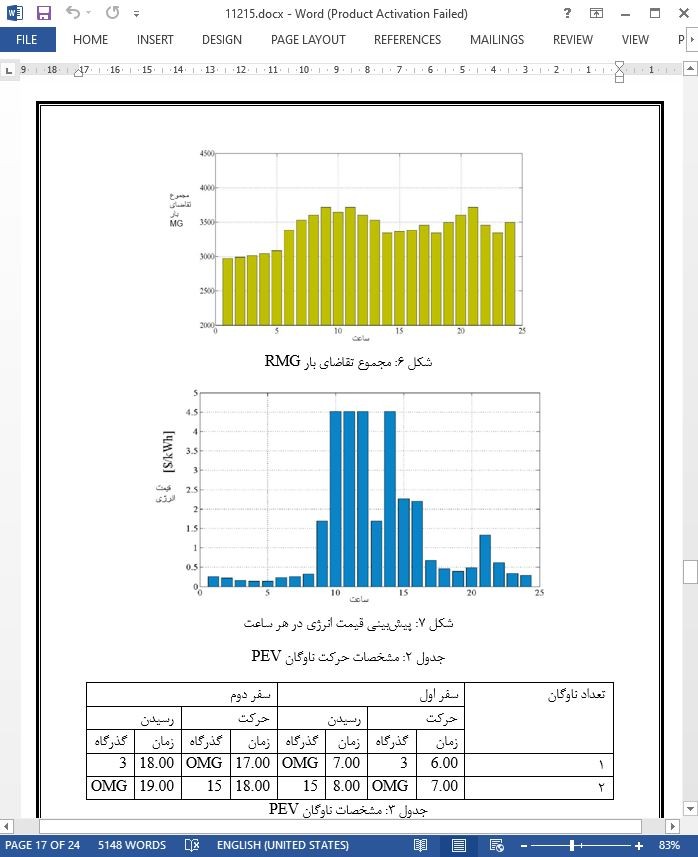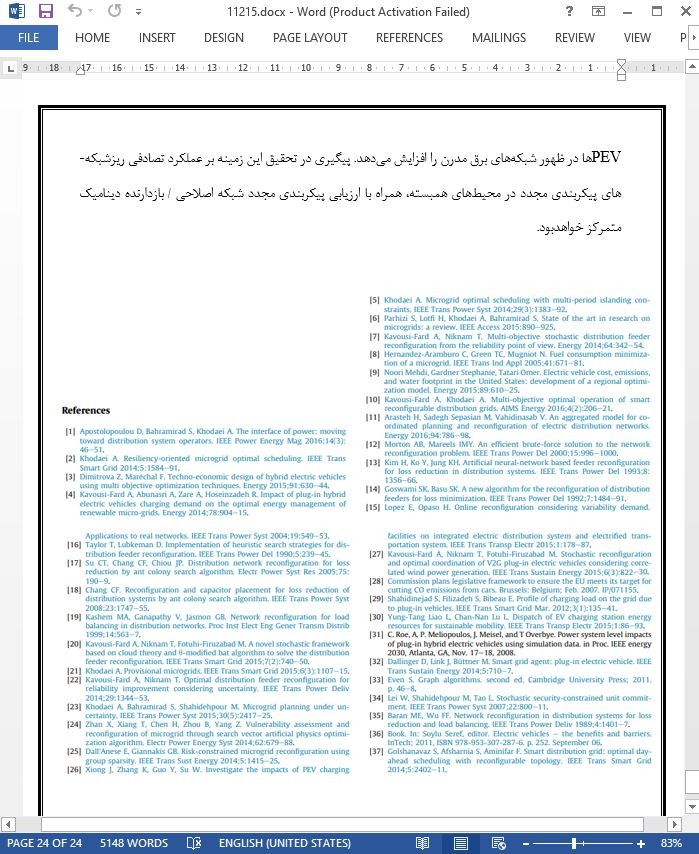
یکپارچگی موثر خودروهای برقی قابل اتصال به شبکه برقی (Plug-in) ازطریق ریزشبکه های با قابلیت پیکربندی مجدد
چکیده
این مقاله زیست پذیری ریزشبکه های با قابلیت پیکربندی مجدد (RMG) را در تسهیل یکپارچگی خودروهای الکتریکی قابل اتصال به شبکه برق (PEVs) بررسی می کند. توانایی پیکربندی مجدد ریزشبکه ها، که با استفاده از سوئیچ های کنترلی راه دور (RCS) فعال می شوند، نفوذ زیاد PEVها و ژنراتورهای توزیع شده تجدیدپذیر را پشتیبانی می کند و با این حال هزینه عملکردی کل را کاهش و قابلیت اطمینان ریزشبکه را نیز ارتقاء می دهد. هدف مسئله برنامه ریزی بهینه پیشنهادی، حداقل کردن هزینه کل تامین برق در PEVها با منابع انرژی پراکنده (DER) و تبادل انرژی شبکه جریان رو به بالا، حداقل کردن هزینه زوال باتری در PEVها، هزینه سوئیچینگ درهنگام پیکربندی مجدد، و هزینه های وقفه قابل انتظار مشتری به عنوان شاخص اطمینان می باشد. برای نشان دادن سطح بالای تردیدها در مسئله، یک چارچوب تصادفی مبتنی بر سناریو به منظور دریافت و کنترل عدم قطعیت ها همراه با مقادیر شارژکردن و تخلیه PEVها، تعداد PEVها در هر ناوگان، زمان روزانه سفرها برای PEVها، مصرف بار ساعتی، توان خروجی ساعتی DGهای تجدیدپذیر، و قیمت ساعتی بازار طراحی شده است. عملکرد رضایت بخش و شایستگی های مدل پیشنهادی بر روی ریزشبکه آزمایشی بررسی شده است.
1. مقدمه
ریزشبکه به عنوان گروهی از بارهای به هم پیوسته و منابع انرژی پراکنده (DER) تعریف می شود که چه در حال اتصال به شبکه کاربرد و چه هنگام انفصال [1] قادر به عملیات می باشد و متعاقبا کیفیت سرویس های الکتریکی به مشتریان محلی را از هر دو منظر عملیاتی و قابلیت اطمینان بهبود می بخشد [2, 3]. برخی از مزیت های اصلی گسترش ریزشبکه را می توان لیست کرد، مانند وقفه های کمتر مشتریان و بهبود قابلیت اطمینان، انتشار کمتر، کیفیت توان بالاتر، کاهش هزینه های عملکردی، و بهره وری بالاتر [4, 5]. این ویژگی های امیدبخش منجربه شروع تحقیقات مهم در عملیات ریزشبکه ها، کنترل، و برنامه ریزی در سال های اخیر شده است. در [6]، چارچوب بهینه-سازی مبتنی بر الگوریتم ژنتیک کدگذاری واقعی ماتریسی به منظور بررسی عملکرد بهینه ریزشبکه پیشنهاد شده است. روش پیشنهادی شامل یک مدول پیش بینی، سیستم ذخیره انرژی، و رویکرد بهینه سازی می باشد. در [7]، روش مبتنی بر برنامه ریزی خطی به منظور کاهش هزینه ریزشبکه خورشیدی – باد هیبریدی با درنظر گرفتن محدودیت های محیطی ارائه شده است.
6. نتیجه گیری
این مقاله مسئله برنامه ریزی بهینه RMG را با درنظر گرفتن DGهای توزیع کننده، DGهای تجدیدپذیر، و ناوگان های PEV بررسی می کند. ابتدا، مسئله به شکل مسئله بهینه سازی تک هدفی مجزای محدود فرمول بندی شد و سپس یم چارچوب بهینه سازی تصادفی مؤثر به منظور مدل سازی اثرات نامشخص (عدم قطعیت) معرفی شد. به منظور بررسی عملکرد چارچوب تصادفی پیشنهادی، سیستم آزمون IEEE بکار می رود و چهار سناریو نیز به منظور برجسته کردن اثر DER، PEV و پیکربندی مجدد توسعه یافت. نتایج شبیه سازی در RMG نمونه نشان داد که درنظر گرفتن راهبرد پیکربندی مجدد زیست پذیری ریزشبکه را هم از نظر هزینه های عملکردی و هم قابلیت اطمینان بهبود می بخشد. همچنین، مشاهده شد که درنظر گرفتن فناوری V2C وضعیت PEVها را از صرف بارها به ذخیره های متحرک ارتقاء می دهد و بنابراین هزینه عملکردی ریزشبکه را کاهش می دهند.
Abstract
This paper investigates the viability of the reconfigurable microgrids (RMGs) in facilitating the integration of plug-in electric vehicles (PEVs). The reconfiguration ability of microgrids, which is enabled by the use of remotely controlled switches (RCSs), will support the high penetration of PEVs and renewable distributed generators (DGs) while reducing the total operation cost and potentially enhance microgrid reliability. The objective of the proposed optimal scheduling problem is to minimize the total cost of power supply by distributed energy resources (DERs) and upstream network energy exchange, battery degradation cost in PEVs, cost of switching during the reconfiguration, and expected customer interruption costs as a reliability index. To address the high level of the uncertainties in the problem, a scenario-based stochastic framework is devised to capture the uncertainties associated with the charging and discharging values of PEVs, number of PEVs in each fleet, time of the daily trips for PEVs, hourly load consumption, hourly output power of renewable DGs, and hourly market price. The satisfying performance and merits of the proposed model are examined on a test microgrid.
1. Introduction
A Microgrid is defined as a group of interconnected loads and distributed energy resources (DER) which can operate either connected to or disconnected from the utility grid [1], and accordingly improve the quality of the electrical services to local customers from both operation and reliability points of view [2,3]. Some of the major benefits of microgrid deployments can be listed as fewer customer interruptions and improved reliability, lowered emissions, higher power quality, reduced operation costs, and higher efficiency [4,5]. These promising features have resulted in initiating significant research on the microgrids operation, control, and planning in recent years. In [6], an optimization framework based on the matrix real-coded genetic algorithm is suggested to investigate the optimal operation of a microgrid. The proposed method consists of a forecasting module, an energy storage system, and an optimization approach. In [7], a method based on linear programming is presented to decrease the cost of a hybrid solar-wind microgrid with regards to the environmental constraints.
6. Conclusion
This paper investigated the optimal scheduling problem of RMGs considering dispatchable DGs, renewable DGs, and PEV fleets. First, the problem was formulated in the form of a constrained discrete single-objective optimization problem and then an efficient stochastic optimization framework was introduced to model the uncertainty effects. In order to examine the performance of the proposed stochastic framework, an IEEE test system was used and four scenarios were developed to highlight the effect of DERs, PEVs, and reconfiguration. The simulation results on a typical RMG showed that considering reconfiguration strategy can improve the microgrid's viability from both operation costs and reliability perspectives. Also, it was seen that considering the V2G technology could enhance the status of PEVs from being just loads to moving storages and thus reduce the microgrid operation cost.
چکیده
نام گذاری
1. مقدمه
2. ریزشبکه های با قابلیت پیکربندی مجدد (RMG)
2 – 1: راهبرد پیکربندی مجدد
2 – 2: فناوری PEV
3. فرمولاسیون مسئله
3 – 1: تابع هدف
3 – 2: محدودیت های مسئله
4. مدل سازی عدم قطعیت ها براساس ایجاد سناریو
4 – 1: ایجاد سناریو
4 – 2: کاهش و تراکم سناریو
5. نتایج شبیه سازی
6. نتیجه گیری
Abstract
Nomenclature
1. Introduction
2. Reconfigurable microgrids (RMG)
2.1. Reconfiguration strategy
2.2. PEV technology
3. Problem formulation
3.1. Objective function
3.2. Problem constraints
4. Modeling uncertainties based on scenario generation
4.1. Scenario generation
4.2. Scenario reduction & aggregation
5. Simulation results
6. Conclusion
- ترجمه فارسی مقاله با فرمت ورد (word) با قابلیت ویرایش، بدون آرم سایت ای ترجمه
- ترجمه فارسی مقاله با فرمت pdf، بدون آرم سایت ای ترجمه



